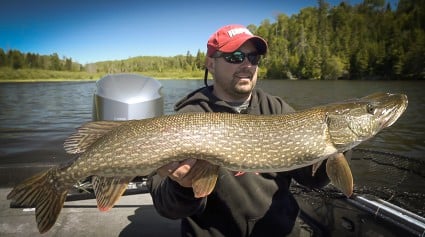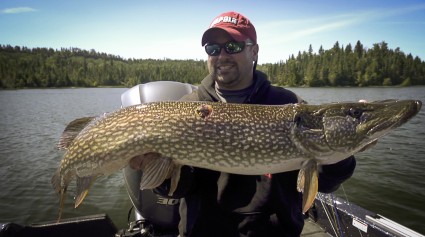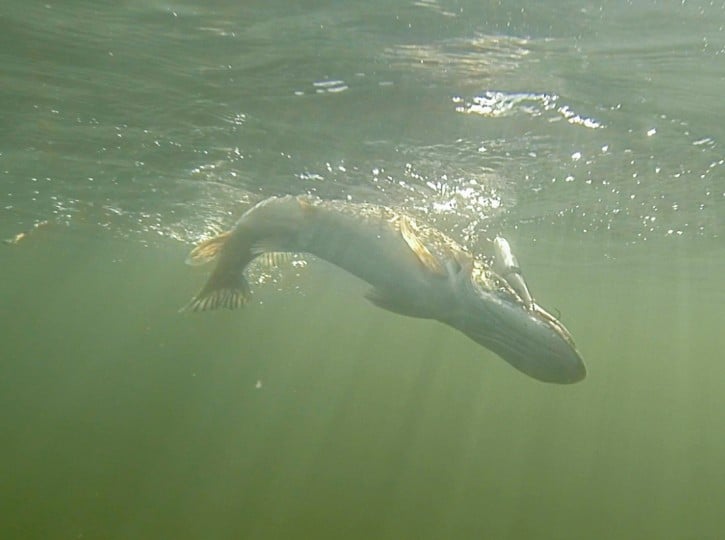It happens every year. Some of the biggest pike in northern reaches of our state are taken in some of the clearest water Minnesota can offer. Beyond our borders, those that take fly-in trips to the north-country and fish steep-sided Canadian shield lakes, often experience the toothy-critter of a lifetime in water with little stain or turbidity. But these fish are not your run of the mill gator, dashing out from cover at the last second, crushing your bait boatside. These fish operate more like the wariest of trout species, complete with the binocular-like vision so common in many salmonids. Still, these monsters are at the pinnacle of this system, and when coaxed into eating, are every bit the aggressors that make this species so impressive. It just takes a slightly different approach to tame the largest pike during your next trip to the BWCA, Canada, or other clear lakes north of the metro.
 Small fish live here too, and dominate the shorelines. Stick to them, as our cast-to-cover mentality beckons us to, and you’re likely to be rewarded with some good fish only occasionally. The rub is that this is typically the more productive numbers pattern, such that positive re-enforcement of pike slamming your baits again and again becomes difficult to break free from. It’s one of the primary reasons that so many people head to clear-water systems known for producing trophy pike, yet come home with only stories, rather than photos, of big fish those lakes are known for. Most of the fish you’re after are a short cast behind the boat, away from shore rather than towards it, on open flats with scattered clumps of good vegetation. I’m not talking scattered sand grass and stringy relatives, I’m talking about the heavy veg., primarily cabbage but also coontail.
Small fish live here too, and dominate the shorelines. Stick to them, as our cast-to-cover mentality beckons us to, and you’re likely to be rewarded with some good fish only occasionally. The rub is that this is typically the more productive numbers pattern, such that positive re-enforcement of pike slamming your baits again and again becomes difficult to break free from. It’s one of the primary reasons that so many people head to clear-water systems known for producing trophy pike, yet come home with only stories, rather than photos, of big fish those lakes are known for. Most of the fish you’re after are a short cast behind the boat, away from shore rather than towards it, on open flats with scattered clumps of good vegetation. I’m not talking scattered sand grass and stringy relatives, I’m talking about the heavy veg., primarily cabbage but also coontail.
We know of large pike and their cold-water requirements, so these flats that have direct access to immediate, deep water are the most desirable, and may only contain fish during the first half of the season. Furthermore, they may only hold fish early or late in the day before sun angle and warmer water prevents their prolonged stay there. That said, a small weedbed on flats as described here might as well be a flag at Augusta National, with the rest of the bay and your fishing strategy setting up like a full round at the Masters. Plain and simple they’re targets, but if you get over-eager and try and push too close to the pin, you’re likely to end up in the sand, which in this game translates to spooked fish and few hook-ups.
 Careful work on the trolling motor is required here, as these fish simply will not tolerate boat traffic overhead. On a bad day of boat control, you’ll see a pile of big fish yet catch very few. On a good day, you’ll lock-in on a hookset long before you ever have the chance to see fish flare boatside. Pick apart bays and adjacent areas from the deep side, or outside-in, knowing that any area you pass over with the boat is dead water, such that your vessel needs to be stationary at times for quite a while as you pick apart the water section-by-section, cast-by-cast. When you do get bit, don’t let wind or big-fish excitement blow you off course, as you are likely within a stones-throw of several giants that use multiple weed-beds or clusters to feed together. Good habitat is good habitat, and you can bet that more than one fish at a time in the lake knows it.
Careful work on the trolling motor is required here, as these fish simply will not tolerate boat traffic overhead. On a bad day of boat control, you’ll see a pile of big fish yet catch very few. On a good day, you’ll lock-in on a hookset long before you ever have the chance to see fish flare boatside. Pick apart bays and adjacent areas from the deep side, or outside-in, knowing that any area you pass over with the boat is dead water, such that your vessel needs to be stationary at times for quite a while as you pick apart the water section-by-section, cast-by-cast. When you do get bit, don’t let wind or big-fish excitement blow you off course, as you are likely within a stones-throw of several giants that use multiple weed-beds or clusters to feed together. Good habitat is good habitat, and you can bet that more than one fish at a time in the lake knows it.
Bait selection here requires some more nuance than what neon buzzing and flashing lures you might otherwise select for big pike, but remember that these are still top-of-the-food-chain type fish we’re after here. One of my favorite style of baits is slowly sinking jerkbaits, especially jointed balsa or balsa-encased baits. Life-life motion on the jerk, and pause portions of the retrieve are critical here, and you need a big bait to entice these fish. Few hard-plastic or other muskie style lures have that same kind of finesse factor you’re looking for. From there, it’s all about long casts and pinpointing these locations before you’re seen by the fish. Rip-rip-pause, and be ready to reel back down and set the hook as these fish typically eat as the bait is slowly sinking. It’s a fun way to fish for trophy pike in water that gives most anglers the fits.
